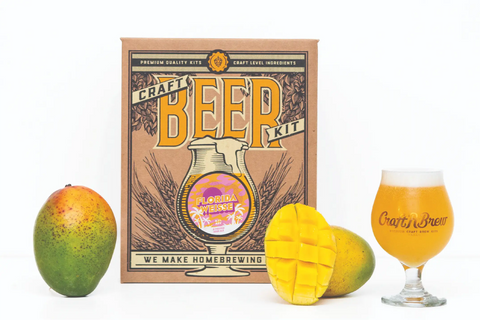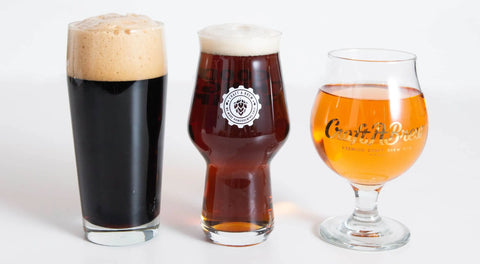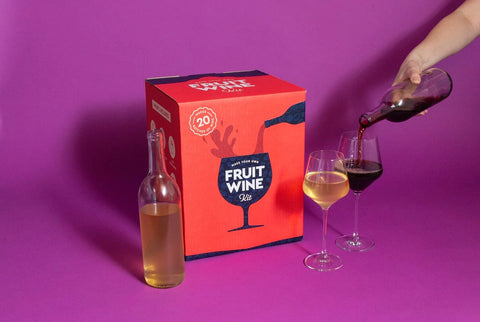TL;DR: Fruit in Beer — Do It Right
Wondering how to add fruit to beer the right way? Brewing beer with fruit is easy, but there are a few things to consider before you begin:
-
When to add fruit to beer: End of boil (pasteurization), secondary fermentation (best flavor), or bottling (extract/tincture).
-
Fruit form matters: Use puree for consistency, frozen fruit for affordability, extracts for control.
-
Balance your recipe: Match fruit to beer style — bold fruit for sours/IPAs, delicate fruit for wheat or blonde ales.
-
Sanitize fruit for homebrew: Use pasteurization, Campden tablets, or pre-sanitized puree to avoid infections in fruit beer.
-
Use less than you think: Start with 0.5–1 lb per gallon for balanced fruit flavor without overwhelming fermentation.
Why Add Fruit to Your Beer?
Fruit beer brewing is one of the most rewarding ways to personalize your homebrew. From tart raspberry wheat beers to juicy mango IPAs, fruit brings natural sweetness, acidity, and aromatic complexity. Many beer ingredients already have fruity notes — citrusy hops, raisin-y grains, or banana-like yeast esters. Fruit additions for homebrewing enhance and complement these flavors, turning a basic recipe into a signature creation.
A standard Hefeweizen becomes a summer favorite with mango, or a basic stout turns festive with cranberries and spices. Homebrew fruit flavoring allows you to experiment and create layered, exciting beers.
When to Add Fruit to Beer
Primary Fermentation
One of the simplest fruit additions for homebrewing: adding to the end of the boil on brew day. This is referred to as adding during primary fermentation. This method yields much subtler fruit flavor and aroma thanks to vigorous yeast activity, which pushes delicate aromas out through the airlock. Much of the fruit sugars will be fermented into alcohol.
Use this method if:
-
You want a drier beer with less pronounced fruit character.
-
Subtle fruit notes are desired.
Tips:
-
Almost any fruit can be used: whole, fresh, or frozen.
-
Avoid no-boil purees, which lose flavor during primary fermentation.
Secondary Fermentation
Adding fruit during secondary fermentation (after yeast activity has leveled off and calmed down) gives you more control over flavor and aroma. Yeast activity has slowed, so less of the fruit’s flavor and aroma are lost to fermentation. A more pronounced fruit character remains in the finished beer.
Best Practices for Secondary Fermentation Fruit Additions:
-
After about 1-2 weeks of fermentation, transfer beer to a sanitized secondary fermenter, preferably one that has more volume than your batch size (example: a 2 gallon bucket for a 1 gallon batch).
-
Add fruit to the secondary fermenter using a nylon fruit straining bag to contain skins, seeds, and pulp.
-
Age beer on the fruit for 7–14+ days.
-
Use ready-to-use, no-boil fruit purees. OR freeze and defrost fresh fruit.
TIP: Buy frozen fruit and defrost (12+ hours or until room temp). Freezing fruit breaks down its cell walls, allowing for more juice extraction.
Bottling
For maximum control over flavor intensity, make your own tincture or “extract:”
-
Soak fruit or citrus peels in a neutral spirit (vodka, rum, or everclear) for 12–72 hours.
-
Discard the solids.
-
Add as much or as little of the infused spirit to your beer before bottling.
-
Taste and adjust dosage as needed.
TIP: Perform "bench trials" to dial in the proper amount of extract you should use.. This is done by adding small ratios of the tincture to small ratios of the fermented beer to see what bourbon to beer ratio works best. You can also add different amounts of the extract to each bottle if you want to perform side-by-side taste tests to tweak your recipe for future batches.
What Form of Fruit Should You Use?
|
Fruit Form |
Pros |
Cons |
|
Puree |
Sterile, easy to dose |
Can add haze or sediment |
|
Frozen Fruit |
Affordable, available year-round , frozen at the peak of freshness |
Best to completely defrost prior to use (can take ~12 hours) |
|
Fresh Fruit |
Bright flavor |
Risk of wild bacteria/yeast |
|
Juice |
Easy to mix, adds sugar |
May lack real fruit character |
|
Tincture |
Potent flavor, small volumes |
Doesn’t contribute color |
Craft a Brew Tip: For beginners, using fruit puree in beer (like Amoretti or Oregon Fruit) is the safest and most consistent option for fruit beer brewing.
How Much Fruit Should You Add?
When planning your fruit additions for homebrewing it’s best to start small. Too much fruit can overwhelm your wort, add excessive fermentable sugar, or clog your fermenter.
-
Light presence: 0.25–0.5 lb per gallon
-
Medium: 0.5–1 lb per gallon
-
Bold flavor: 1–2 lbs per gallon
TIP: Keep a brewing journal to log your fruit measurements. If you love your beer, you’ll know exactly how to recreate the recipe. If it needed more (or less) fruit, you’ll have a point of reference.
How to Sanitize Fruit
Fruit and produce skins often carry wild yeast and bacteria that can outcompete your yeast and seriously ruin a batch. To ensure that you’re avoiding infections in fruit beer, be sure to use one of these methods:
-
Heat: Add fruit at the last 5–10 minutes of the boil (if adding to primary). OR simmer on the stove for 5-10 minutes and let cool (if adding to secondary). This is enough to kill wild yeast or bacteria, though it will kill some of the fruit’s delicate aromas.
-
Campden Tablets: In a sanitized container, crush 1 campden tablet over your fruit. Seal and let the tablet sterilize the fruit for 24 hours. After 24 hours, fruit is safe to add to secondary.
-
Pre-packaged Purees: Aseptic purees are often safe and ready to use out of the package - no boiling or sterilization required!
How to Add Fruit Step-by-Step
-
Choose your fruit
Match fruit to style: raspberries for wheat beers, mango or pineapple for IPAs, cherries for stouts/porters, citrus zest for Belgian ales.
Decide on the form: frozen fruit (affordable, breaks down easily), fruit puree in beer (consistent and sanitized), fresh fruit (bright flavor but riskier), or tinctures/extracts (best for bottling day).
-
Prepare and sanitize your fruit
-
End of boil (primary): Add fruit with 5–10 minutes left in the boil to pasteurize. Best for citrus zest, stone fruits, or fresh fruit you want fully integrated into the wort.
-
Secondary fermentation fruit: Use frozen/thawed fruit or no-boil purees. Sanitize with Campden tablets if using raw fruit. This preserves more aroma and flavor without blowing it off during vigorous fermentation.
-
Bottling day: Make a tincture (soak fruit or zest in vodka for 1–2 weeks) or use a high-quality extract. This gives the most control over intensity since you can dose “to taste.”
-
Add fruit to the fermenter
If using secondary fermentation, transfer beer into a sanitized fermenter (preferably a large bucket with extra headspace), add the fruit, and gently stir with a sanitized spoon. A nylon fruit bag helps keep seeds and skins contained.
-
Fermentation time
In secondary, let the beer age on fruit for 7–14 days until fermentation activity slows. Monitor gravity if aiming for a specific ABV or sweetness level.
-
Cold crash (optional)
Chill the fermenter to near-freezing for 48 hours before packaging. This helps settle out fruit debris and yeast for a cleaner final beer.
-
Package as usual
Siphon off the fruit solids and bottle or keg. If adding tinctures or extracts, mix them into your priming sugar solution before bottling.
Best Styles & Best Fruits for Beer
-
Wheat Beers: Just about any fruit works beautifully in a wheat ale. Try raspberry, citrus or stone fruit.
-
IPAs: Bold, tropical fruits like pineapple, mango, grapefruit will complement bold, juicy hops
-
Sours: Cherry or passionfruit lean into the lactic acid sourness, while soft fruits like blueberry or strawberry can help provide a mellow balance.
-
Stouts & Porters: Bold, complex fruit flavors can enhance a stout’s roasty, chocolatey flavors. Think tart cherry, raspberry, fig or other dessert-like fruit pairings.
-
Blondes & Cream Ales: Light beers pair well with delicate fruits like strawberry, peach or even lime.
Want to try a ready-to-go fruit beer?
Craft a Brew’s Florida Weisse Kit and Hefeweizen Kit are beginner-friendly starting points.
Common Mistakes to Avoid
-
Using too much fruit
More isn’t always better. Adding more than 1–2 lbs of fruit per gallon can overwhelm the base beer, create excessive sweetness, or stall fermentation with unfermentable sugars. Start small and scale up in future batches.
-
Adding fruit directly to bottles
Fresh fruit contains fermentable sugars. If you add it when bottling, yeast will keep fermenting inside the bottle, leading to over-carbonation — or worse, exploding bottles. Always add fruit during fermentation or use a tincture/extract at bottling day instead.
-
Skipping sanitation on fresh fruit
Raw fruit skins carry wild yeast and bacteria. Without proper prep, you risk infections in fruit beer that can ruin an entire batch. Always sanitize fruit with pasteurization, Campden tablets, or use pre-packaged fruit puree.
-
Adding delicate fruit too early in the fermentation process
Aromatic fruits like strawberries, blueberries, and peaches lose much of their character if added in vigorous primary fermentation. CO₂ scrubs out aroma, leaving behind little more than sugar. For best results, save delicate fruit additions for secondary fermentation.
-
Forgetting to adjust fermenter volume
Fruit takes up space — a few pounds of berries or puree can easily displace half a gallon or more. If your fermenter is already full, adding fruit can cause messy blow-off or spillage. Always leave headspace or use a larger secondary fermenter when planning fruit additions.
Final Thoughts
Brewing beer with fruit can elevate your homebrew or derail it if done incorrectly. Adding fruit during secondary fermentation, using sanitized puree or frozen fruit, and patiently letting the beer mature ensures bold flavor, balanced sweetness, and a smooth finish. Experiment with different fruits and techniques to create your signature beer.
Want a Kit That’s Fruit-Friendly?
Explore Craft a Brew’s beer kit collection, including seasonal styles like the Peach Saison Kit. Many kits are designed to pair beautifully with fruit, making fruit beer brewing approachable and fun.





